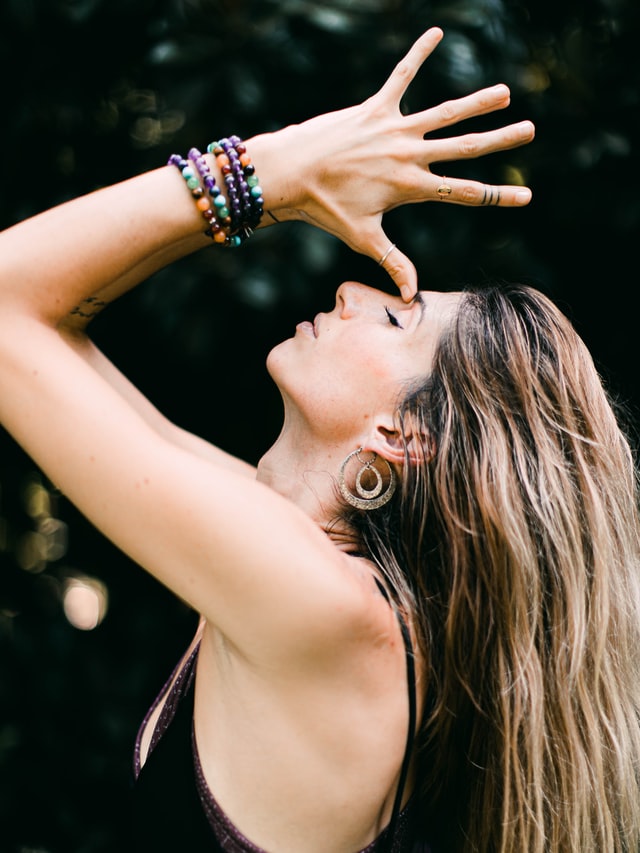Sun Salutation A is a prayer of gratitude to the sun for the life it provides on Earth.
It consists of 12 postures sequenced to perfection, designed to prepare the body for what’s to come. It is an offering of genuine gratitude for all the sun does to make our lives bright.
Most students think it’s a warm-up to get the body’s juices flowing, and it is. That’s the beauty of it.
To keep students in the dark about why we practice this prayer in motion at the beginning of our practice would be shady at best.
I share the true meaning of Surya A and it opens students’ eyes to how sacred these movements actually are. The body moves in reverence using breath and postures to communicate. Students hold the practice in a completely different way. I can see it in the way they stand and I can literally watch their expression soften.
If I didn’t enlighten students, it would be like guiding them through a beautiful practice and having them roll up their mats right before offering savasana, the final resting pose.
Savasana (shah-vahs-uh-nuh) is as much a state of mind as it is a pose, though its name is Corpse pose. It is the cherry on top of any practice—good, bad, or ugly.
Some students judge their practice, so this is a time to lay all of that to bed. It may be the most important pose in the practice—a quiet mind and a resting body. The right savasana can feel as satisfying as a full night of sleep.
We start a yoga practice with gentle movement and breathing. It is a time to wake up the body and the breath, so we focus our energy on both.
Early on, we sync the two. Each breath has a movement and each movement has a breath. Breath and movement work together like Q and U. It’s a unique relationship and the essence of what makes yoga different from any other form of movement. It is an exercise, but I don’t regard it as exercise. For me, it’s a work in, not a work out.
We practice yoga on the mat, and we live it off the mat.
Once the body is warm and we are standing, we move into Sun Salutations. This is the true start of our practice and is based in deep gratitude. In a church, people kneel; in yoga, we stand when we pray.
1. Tadasana, or Mountain pose, at the top of the mat, is where we begin. We stand tall with our feet firmly on the ground. The more rooted we feel, the less likely we are to feel shaky or wobbly. We press all four corners of our feet into the earth and simultaneously lift everything up including the crown of our head to the heavens. We root down to rise up.
2. Our arms sweep up for urdhva hastasana; it’s an upward salute. We offer ourselves up to the goddess of the sun. We reach up to the sun with all that we have, hearts wide open.
3. We fold forward in uttanasana, hinging from the hips. We bow humbly in deference to the gods. Some cultures cover their feet, others their head; we bow, fold forward in namaste. The divine light in me honors the same divine light in you.
4. We inhale and lift halfway, ardha uttanasana. We reach our hearts forward rather than up; this keeps the spine long. I like to think this is me having the sun’s back. If she needs to lay anything down that she has been carrying and feels heavy, I am offering her a spot. Lengthening the spine is the objective of almost every pose in yoga, crown over tail.
5. Exhale to Plank pose, kumbhakasana. In layman’s terms, Plank pose is the top of a push-up; the head, the heart, the hips, and the heels line up. This pose has a sole purpose. It teaches us to hold it together when we’re not sure we can. That way when something in life really rocks us, we know we can be still and it will pass.
This pose is an opportunity to become stronger than we were when we walked into the room. How many times in our lives has life presented an opportunity for growth and we didn’t want to be that uncomfortable so we missed out? I encourage my students to thank plank for all that it teaches. Most people have a love/hate relationship with plank but many people have the same relationship with personal growth.
6. From plank, we lower to chaturanga dandasana, the bottom of a pushup, which is not the floor (but heading to the floor is an option as well). It’s all about making the practice your own, so you get to choose. And as in life, you get to own the consequences of your choices. If you muscle through because your ego wants to impress, you may regret that the next day. These challenging postures show us how important it is to honor our bodies in all that we do.
7. Inhale Baby Cobra, Cobra, or Upward Facing Dog (urdhva mukha svanasana)—it’s a backbend of your choice. Baby Cobra is a mini backbend lifting chin and chest, Cobra incorporates the lifting of the belly button, and urdhva mukha svanasana is the entire body lifting upward from the floor, tops of the feet pressing into the ground. Gaze goes up, but not the chin. It’s an offering to the sun of our heart, again. A reminder that we are willing to give what we have.
8. Exhale, adho mukha svanasana—Downward Facing Dog. This is a stretch in the arms and the legs in the shape of a capital V. The spine is long or “straight” from fingertips to tail and the legs are long from tail to heels. The core is engaged and the head hangs gently so the neck can rest.
I tell my students that this pose is a lot like a strong marriage. The body isn’t offering 50/50 here and neither is either partner in a healthy marriage. It’s a 100/100—all in.
9. Find your way to the top of your mat, baby steps, bunny hop, hippity hop, lift one foot and then the other. Honor where you are. It doesn’t have to be pretty—you just have to get there. Make it work, or better yet, make it play.
10. Inhale and reach the heart forward while lengthening the spine. Can there ever be too much heart?
11. Exhale forward and bend in admiration, uttanasana. Sometimes we just honor.
12. Inhale and sweep your hands out and up to the sun and draw them to your heart center for Prayer pose, pranamasana.
The sun doesn’t shine to receive recognition. The sun shines because that is what the sun does.
Our own good deeds in life may help many. The question I pose is: what motivated the action? It doesn’t make them any less beneficial to others but it may rob us of the true meaning of giving. There is gratitude in giving when it is done from the heart.
Sometimes we offer an act of kindness and unconsciously wait for one in return. Are we keeping score? Is it possible our high schoolers feed the hungry and volunteer at the homeless shelter to beef up their college applications? Have we as a culture taught them to have an agenda in their goodness. They still get the benefit of these experiences on their life journey, but it’s interesting to inspect what the path was.
What would “look good”? Perhaps we donate to a good cause. That’s helpful, right? But did we donate because it felt right or so others will know how charitable we are? Our motives may have become jaded in the frantic pace of our lifestyle.
I ask my students at the completion of Surya A to close their eyes and think about who and what makes a difference in their day. Is it the 10 minutes sitting under the banyan tree for a break from it all? Is it the doorman in their building who always offers a smile? Is it the silent 75-minute yoga practice? Is it the cashier at Starbucks with the cute giggle? Perhaps it’s the parking attendant at work who delights in entertaining? Is it the wonderful woman in the cafeteria who scoops your creamed corn? Is it the friendly janitor in your building who is as humble as he is wise? Do you recharge your battery by taking a walk on the beach with a friend?
We’ve grown to rely on things that exist. These are the people, places, and things we may take for granted because we know that’s what they do.
Sun Salutation A is a celebration of anything that makes our lives sparklier, stronger, or more authentic. Do we acknowledge the contributions others make to our life? Do we take it to the next level and actually extend gratitude? Have you thanked your favorite oak tree for providing shade?
Gratitude takes on its superpower when it is shared. Taking it with us is the booby prize.
My hope is that practicing Surya A heals the body, of course. I mostly teach it to soften edges. I intend for it to smooth out rough spots, and I believe the warmth of our breath starts to melt away anything that might be feeling stuck or stale that needs to be released.
Ultimately, my hope is that students hold on to the grace they create, and take a piece of it with them when they roll up their mat. I encourage them to sprinkle their brand of magic on those people, places, and things that do the same for them daily.
Magic dust comes in many shapes and sizes. It can manifest in a kind glance across a room; you could pay a good deed forward, or hold the door for someone—just because. I encourage students to leave their practice and shine their light on anyone who appears to have forgotten their own, so they can see where they need to be.
We can change the world, one grateful gesture at a time.
I start every day on my mat. It teaches me what I need to know about being grateful, through silver linings, lessons, magical moments, and joie de vivre.
When I finish practicing, I make it my business to leave everyone that crosses my path a little shinier than they were before we met, no matter the encounter. This is my yoga off the mat. It’s why I keep practicing. I truly believe yoga makes us better at living.
And so far, it’s been my greatest teacher.
~









Read 40 comments and reply